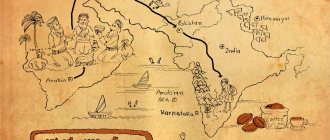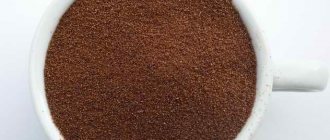Coffee is not called a drug for nothing. People drink it in the morning, at lunchtime, and sometimes in the evening. Such a ritual helps to cheer up, concentrate attention, improve performance, and lift your spirits. To prepare a hot or cold aromatic drink, connoisseurs use their favorite varieties and types of roasted and ground grains. Among the “dependent” countries in terms of coffee consumption per capita are Finland, Norway, and Iceland.
What is known about the elixir of vigor?
The fruits of the coffee tree were known as early as 850. However, it was only centuries later that the grains gained universal recognition. In Russia, they were originally used as a remedy for certain diseases. Statistics on coffee consumption in Russia began at the beginning of the 18th century. Peter I introduced the fashion for the drink among the nobles. Coffee Facts:
- The edibility of the plant's fruits was discovered by the Ethiopians. They noticed that herds of goats happily consumed the berries;
- contains many useful substances (as a percentage of the daily value): potassium, manganese - 3%, vitamin B5 - 6%, B2 - 1%;
- The calorie content of the drink is 2 kcal per 100 ml;
- consuming ground coffee immediately after waking up prevents the formation of cortisol in the body (the hormone responsible for alertness and concentration). Therefore, it is recommended to drink the drink closer to noon.
International Coffee Day is October 1st. However, in some countries the holiday is celebrated at a different time. Coffee consumption remains common - as a tribute to the love of the drink.
Coffee shops and coffee culture
Despite the fact that public catering purchased only 13% of the coffee consumed in Russia in 2021, this market segment is actively growing. In 2021, experts from the consulting company Knight Frank conducted a study of the coffee shop market in Russian cities with a population of over a million. As of 2021, they counted about 5 thousand coffee shops, and the total market volume was estimated at 130 billion rubles. The growth potential, taking into account demand, is 1 trillion, that is, 7.6 times.
Russians “don’t finish their coffee” worth 1 trillion rubles, press release Knight FrankPDF, 311 KB
In economic surveys, surges in the popularity of coffee shops are divided into three periods, which are called waves. There are different opinions on how to count them. Knight Frank divides coffee periods in Russia like this.
The first wave is cafes launched between 1998 and the early 2000s. These are, as a rule, chain establishments that have shaped the culture of coffee consumption in public catering in cities. For example, such large chains as Shokoladnitsa, Coffee House and Traveler's coffee. The achievement of the first wave is that city residents began to actively consume coffee outside the home.
The second wave is the massive emergence of chains focused on selling coffee to go. The beginning of this period is associated with the opening of Starbucks outlets in Russia in 2007. Following this, Russian chains such as Kofein and Coffeeshop began to appear.
The third wave began, according to Knight Frank, around 2021 and continues now. Consumers began to understand coffee, establishments began to adapt to this demand - prepare craft drinks, improve roasting technologies, and purchase the most modern equipment. New large chains are developing in the country, such as Doubleby and Pravda Coffee, but small signature coffee shops are also opening en masse.
If in 2021 Knight Frank counted 5 thousand coffee shops in million-plus cities, then by October 2021 their number increased almost one and a half times - to 7.4 thousand. According to 2GIS data, in Novosibirsk the number of coffee shops has increased 1.7 times over these three years, from 290 to 488 establishments. In Moscow - one and a half times, from 1.6 to 2.5 thousand; in Voronezh - doubled, from 73 to 158.
Coffee production volumes
Production volumes of coffee products have increased by 82% over 10 years. Main manufacturers:
- Brazil – 9.56 million tons;
- Vietnam – 3.16 million tons;
- Colombia - 840 thousand tons;
- Indonesia – 654 thousand tons;
- Ethiopia – 459 thousand tons.
Approximately one third of raw materials are consumed by producing countries. The remainder is exported to European countries, Russia, the USA, Canada, and Japan.
Re-exporters play an equally important role. Most of them are in the countries of the European Union.
Statistics of coffee consumption in the world
Finland ranks first in the world. Annual product consumption per person is more than 9 kg. In India and China they do not favor the drink - 0.1 kg. TOP 5 countries for coffee consumption:
- Finland – 9.6 kg;
- Norway – 7.2 kg;
- Holland – 6.7 kg;
- Slovenia – 6.1 kg;
- Austria – 5.5 kg.
The world leader in the production of the drink ranks 10th in the ranking. Per capita coffee consumption in Brazil is only 4.8 kg.
The annual growth of indicators in the world is also facilitated by the increase in the number of coffee shops. Moreover, the situation differs across countries. For example, the rate of drink consumption in the countries of the former Soviet Union is about 1 kg per year (Ukraine - 1.4, Belarus - 0.6). However, global coffee consumption per capita is growing annually by 3–4%.
Rating of leading coffee countries in 2021
Canada
Among non-European countries, Canada drinks the most coffee. Each of the 37 million Canadians consumes 6.5 kg of grains per year.
Chain catering places are common here, where you can order a glass of aromatic drink. There are small coffee shops. Canadians also enjoy cocktails at home. Perhaps it's all about the cold down to -35 degrees. Although Canadian residents claim that this is a tradition.
Luxembourg
In terms of the amount of grains per person per year, residents of Luxembourg caught up with Canadians - 6.5 kg. And this despite the fact that 590,667 people live in the country (as of January 2021).
Luxembourg's 2,586.4 square kilometers are home to many coffee shops and street coffee machines.
Belgium
Residents of Belgium are famous for their national waffles and beer. But they also love chocolate and drink coffee. There are 6.8 kg of grains per Belgian per year. The main suppliers are Congo and Rwanda.
Switzerland
Filter coffee is not popular in Switzerland. Espresso and drinks based on it are popular. Each Swiss consumes up to 7.9 kg per year. And the high cost of a portion of 3.5 dollars does not become an obstacle.
Sweden
For Swedish residents, coffee with fresh baked goods or other sweets is an integral part of life. Swedes enjoy it in public places, in a homely atmosphere and call it “fika”.
Consumption comes down to 8.2 kg per Swede.
Netherlands
The Dutch are the first Europeans to grow coffee trees. Thanks to this, Holland has become one of the major suppliers of grains to Europe. Find out more in the article “Where Coffee Really Grows.”
The most popular places in the south of the Netherlands are places where coffee cocktails are served together with the sweet vlaaj cake. Modest northerners drink it only with cookies. One Dutch person consumes 8.4 kg per year.
Denmark
In Denmark, coffee is revered and considered one of the main non-alcoholic drinks, especially at celebrations. During a simple snack, it is traditionally served at the end of the meal. For cooking, the Danes make teapots called bodum.
Each Danish resident uses 8.7 kg of grain per year and drinks the drink with sweets or sandwiches.
Iceland
In Iceland, there are large and small cafes in every city. This is how Icelanders create comfort for themselves when the temperature around them is no more than 10 degrees Celsius.
In Iceland, competitions between baristas in preparing lattes with designs on the foam are popular. Coffee consumption per capita reaches 9 kg per year.
Norway
When Norway was a colony of Denmark, coffee was cheap and could be afforded by many. The situation has not changed to this day. Norwegians eat their favorite delicacy with desserts and pies, consuming up to 9.9 kg per year.
A popular cocktail in Norway is called karsk. It is weakly brewed and combined with vodka or local moonshine. When they want to reduce the strength, the liquid is set on fire to burn off some of the alcohol.
Finland
Finland took 1st place. More coffee is drunk here than in the rest of the world. Every year, one Finn produces up to 12 kg of grains.
For Finns, drinking hot coffee is the meaning of communication and weakness. And so serious that doctors classify it as an unhealthy habit. It accompanies any conversation during the day; snacks include sandwiches, pastries, and cakes.
For brewing, Finns use the Turkish version - they bring water and grounds to a boil in a Turkish pot. They roast the grains lightly, so the drink turns out the same. Nowhere else in the world do they drink like this.
Russian market
Russia is an importer and re-exporter of coffee products. From Brazil, Italy and Vietnam comes:
- Arabica grain – 52%;
- unroasted robusta – 30%;
- other varieties – 14%.
Processed raw materials are exported to the CIS countries. Product types:
- ground and granulated coffee – 71%;
- grain raw materials – 28%;
- decaffeinated products – 0.5%.
Previously, Russians bought instant coffee. In 2001, only 31% of the population preferred grain. However, in 2021 the figure has risen to 51%. The development of a consumer culture and an increase in the number of coffee shops contributes to the growth in the number of coffee bean lovers.
Malaysia
Traditional coffee in this country is called yuanyang. And, in fact, it is conditionally considered coffee, because it also includes tea - a special one, prepared from black tea leaves poured with boiling milk. Two parts of this drink are mixed with one part of espresso and the resulting blend is drunk hot or chilled, depending on the weather.
Cooking methods
To prepare the drink, special utensils and mechanized means are used - cezve (Turkish), coffee pots, coffee makers and coffee machines. Coffee recipes combine traditions from different countries:
- Italy. The country is the birthplace of espresso. There are strict requirements for preparing the drink - a cup of coffee must be ellipsoidal in shape and no more than 75 ml in volume. The foam should cover the entire surface and be of a certain color.
- Ireland. Irish coffee was invented by D. Sheridan at the beginning of the twentieth century. The drink should contain a small amount of whiskey and cream. The dairy product is added using the convex side of a spoon. The strength of the drink is 12–15 degrees, calorie content is 250 kcal.
- Bavaria. Bavarian coffee uses egg yolks, gelatin, and milk. The drink is not brought to a boil. It is removed from the heat at a temperature of 82–85°C.
- Türkiye. Turkish coffee is widely known in North Africa, the Middle East, the Balkans, and the Caucasus. Traditionally, the drink is prepared in a Turk and served in small cups. Recipe proportion – 1 g. coffee for 7 gr. water.
Health effects
Over the years of consumption of the drink, various studies have been conducted on its effect on the human body. Coffee consumption statistics show that moderate amounts of the drink are good for your health.
The consumption rate is calculated based on the permissible amount of caffeine per day - 400 mg. Caffeine content table:
The National Institutes of Health conducted its own studies on the health benefits of coffee. Research results:
- the drink reduces the risk of type 2 diabetes by 9%;
- Drinking 4 cups of coffee per day reduces the risk of death from cardiovascular disease by 16%;
- two cups of natural coffee a day reduces the risk of cancer. For example, prostate cancer by 2.5%;
- It is not advisable for pregnant women to drink coffee. For example, consuming 7 cups of drink per day can lead to exacerbations and premature birth;
- metabolism increases by 20%. Therefore, coffee consumption is recommended for weight loss;
- consumption 10 g. caffeine per day can be fatal.
Denmark - 5.3 kg of grain (1.46 cups per day per person)
If the northern Scandinavian countries, as you will learn below, can be called the kings of coffee, then Denmark, accordingly, is the coffee princess. The average person in this kingdom drinks almost one and a half cups of coffee every day. At the same time, the price of coffee in Denmark is one of the highest, so such a portion costs the Danes about one crown.
As in other Scandinavian countries, coffee in Denmark is traditionally served at every meal with cakes, cookies and small sandwiches. Coffee is also the main non-alcoholic drink at gala evenings and receptions. To prepare this drink, special teapots called “Bodum” are even made in Denmark.
For chronic diseases
A serving of black coffee to patients with low blood pressure raises it by 10–15 mmHg. Art. For hypertensive patients, the same dose of drink increases blood pressure by 1–4 mmHg. Art.
However, scientists cannot say for sure whether it is worth drinking coffee if you have high blood pressure. Much depends on the age, general health of the person and the presence of concomitant diseases.
Drinking coffee if you have diabetes is not recommended. The drink promotes weight loss, but increases blood glucose levels. Green coffee is less harmful to diabetics.
You also need to be careful if you have gastrointestinal problems. For gastritis, coffee can only be consumed from natural beans with milk with a fat content of up to 2.5%.
Senegal
Senegalese coffee is prepared in a special way. It requires a mixture of spices, which necessarily includes African pepper and clove buds. Seasonings are roasted together with coffee beans, and then ground with them and brewed that way. The resulting drink is called cafe touba.
When breastfeeding
Statistics on coffee consumption in Russia show that the drink affects the baby’s body through mother’s milk. Therefore, a logical question arises: is it possible to drink coffee while breastfeeding? The key is the number of drinks you drink. The rate at which caffeine is eliminated from the body depends on the age of the baby:
- premature babies – 65–103 hours;
- up to 3 months – 80–97 hours;
- from 3 to 6 months – 14 hours;
- over 6 months – 5 hours.
The maximum concentration of caffeine in breast milk after a serving of coffee is reached after an hour, and is completely eliminated from the body after 5–6 hours. Therefore, consumption of the drink during lactation is undesirable.
Sweden 8.2 kg.
In Sweden there is an expression “fika”, which is perceived as going out for coffee. In this case, they drink coffee either with cookies or with fresh pastries. Various situations can be classified as “fika”, such as a short break from work or a meeting with friends, most importantly, the availability of coffee. For some, this is not just a drink, but a way of life, a necessary element of communication and a pleasant time with friends and colleagues.











